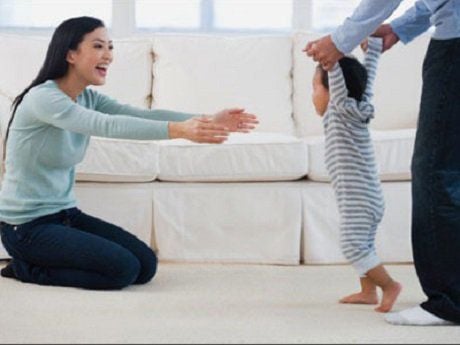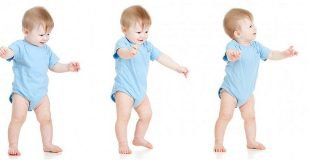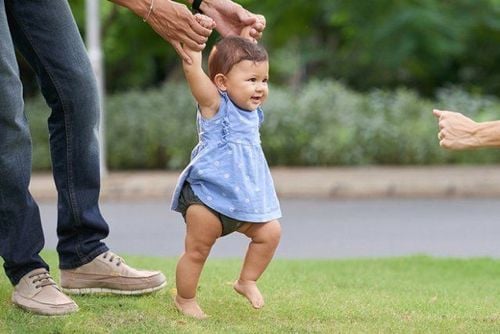This is an automatically translated article.
The article is professionally consulted by Resident Doctor Ho Thi Hong Tho - Neonatologist - Pediatrics - Neonatology Department - Vinmec Phu Quoc International General Hospital
Toddlers are one of the signs that help parents realize the good development of their children. As the baby's muscle strength develops, this action becomes easier too. So, how will the ability to walk and the development of this activity take place by age?
1. When the baby can walk
Most babies take their first steps between 9 and 12 months and walk well by the time they are 14 or 15 months old. However, don't worry if your child takes a little longer. Some babies are completely normal if they don't walk until they are 16 or 17 months old. During her first year, babies are focusing on developing coordination and muscle strength in every part of their body. Your baby will learn to sit, roll and crawl before moving on to standing at around 9 months.
2. Detailed timeline of developing toddler's ability by age:
2.1. Infants and young children Newborns up to 2 months : Has a step reflex. If held in a standing position on a hard surface, infants will move their legs as if they were walking. The reflex disappears around 2 months of age. Baby 3 to 4 months: Have a mini push-up activity. That means your baby can lie on his stomach and lift his head and chest off the ground, using his arms for support. Mini push-ups help your baby build upper body muscles that are important for walking.

Trẻ 3-4 tháng tuổi đã bắt đầu có hoạt động chống đẩy mini (lẫy)
5 months baby : Jumps up and down when held in a standing position. This move helps children build leg strength. Begin the "tripod" by leaning on your baby's arms for support while sitting. Baby 6 to 8 months: Learn to sit. Sitting without support requires neck strength, head control, balance, and coordination. These are all important skills for your baby to develop walking. Most babies also learn to crawl between the ages of 7 and 12 months, although some babies skip it altogether and go straight to learning to walk. At this stage, your baby can stand while holding something to help him stand more firmly. If your baby can't bear the weight of his legs when you pick him up, or can't sit by 9 months, come over. See a doctor to find out the causes and measures to improve this condition.. Baby 9 to 12 months: Your baby can now stand up on his own with the support of a sturdy object, such as a sofa. or table legs. At the same time, your baby is also starting to figure out how to bend his knees deeply to sit after standing. That said, it won't be long before your baby takes long strides while clinging to anything nearby for support. Moreover, the baby can also stand unsupported for a few seconds and can walk while holding hands. At this point, the baby can take his first steps! Although, the walking ability of beginners and children is not strong enough to be able to do it on their own. 2.2. Toddlers 12 to 15 months old: babies may be taking steps, although they are still a lot awkward. (Those outstretched arms when walking really help with balance.) Before long, your baby will learn to stoop and stand up again. When your baby is on the move, he may like toys that can help him do push and pull activities more easily. If your baby can't walk by 14 or 15 months, see a doctor. This is still well within a child's normal developmental range, but this is a good time to check for any abnormalities that may be delaying your baby's development at the milestone.
Baby 15 to 18 months: With help, baby can go up and down stairs. Babies can even walk backwards or dance to the music. Baby 18 to 24 months: This is the time when the baby can increase the walking speed to perform running activities. By her second birthday, she can kick a ball, stand on tiptoes, carry something in her arms while walking, and jump from low steps to the floor.

Trẻ 24 tháng tuổi đã có thể thực hiện hoạt động chạy nhảy nhanh nhẹn
2.3. Preschooler Baby 25 to 30 months: baby can maneuver up and down stairs while clinging to handrails or your hands for support. Moreover, now the baby can feel more comfortable when running. Baby 31 to 36 months: Your baby can now jump on the ground, can use one or both feet together, or can pull his legs to the left and right. By age 3, your baby can go up and down stairs by alternating feet on each step. 4 years old: This is the time when your baby can learn to balance and jump - on one foot. Your baby may prefer one foot to the other. Can go up and down stairs without assistance. 2.4. Older child 5-year-old baby: now he has mastered previous skills and can now do all these activities more smoothly and easily like walking, running, hopscotch, or baby You can skip these activities and just do the jump.
3. How to help your baby learn to walk
As your baby learns to stand up on her own, she may need some help figuring out how to get back up. If your baby is struggling and crying, don't just pick him up and hold him down. At this point, show your child how to bend his knees so that he can sit down without tipping over and let him try these actions on his own.
You can encourage your baby to walk by standing or kneeling in front of him and extending your arms. Or you can take both of your baby's hands and let him walk towards you. Your baby may also like a walker or push toy that she can hold while walking. (Find a toddler toy that is stable and has a wide base.)
Always make sure your baby has a soft and safe environment in which to hone his new skills. Follow standard babysitting guidelines and never leave a baby unattended.

Cha mẹ nên khuyến khích và tạo môi trường cho bé có thể tập đi
4. Some questions to help children develop the ability to walk
Should you buy a baby walker? The American Academy of Pediatrics (AAP) discourages the use of baby walkers. Since they make it easy for your baby to walk, walkers may prevent your baby's leg muscles from developing correctly. And because they make it possible for babies to reach hot items or toxins that a normal child cannot reach, they are less safe.
When should my child wear shoes? Don't introduce shoes until your baby is regularly walking outside or on rough or cold surfaces. Going barefoot improves balance and coordination.
What to do if your baby can't walk Don't worry if your baby simply doesn't spend his time learning to walk. But if your baby is unsteady by 12 months, can't walk by 18 months, or can't walk steadily by age 2, take him or her to the doctor.
Remember that babies have different schedules and premature babies may reach this and other milestones later than their peers. If your baby was born prematurely, you should calculate your baby's milestones from your due date, which pediatricians call your baby's adjusted age.

Hãy đến gặp bác sĩ nếu thấy con có những dấu hiệu không biết đi
Please regularly visit Vinmec.com website and update useful information to take care of your baby and family.
Reference source: babycenter.com














